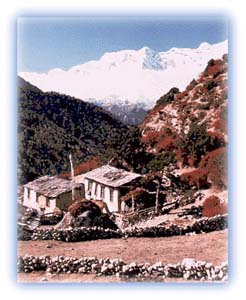Nepal Himalayas
General Info
· Solo Khumbu
· Namche Bazar
· Thyangboche
· Pangboche
· Kalapattar
· Pheriche
· Buddhism in Khumbu
· Mount Everest
· The Quest for Everest
· Early Years
· The 1950s
· Sherpas on Everest
· Central Nepal
· Mustang
· Jomsom
· People: Thakalis
· Muktinath
· Manang valley
· Bryagu village
· Manang village
· Nyasang Division
· Western Nepal
· Jumla
· Sukhadik
Photo Feature:
· Annapurna region
High Altitude Sickness
Endangered Species
Protected Areas
Yaks
The Yeti Factor

![]()
|
Sherpas -- The Tigers of the Mountains Together with the brave Gurkha soldiers of Nepal, the Sherpas are among the most world-famous of Nepalese people. The world's highest-living population, the Sherpas are born mountaineers. It is their fantastic mountaineering prowess and their hardiness that brought them into prominence in mountaineering circles in the early parts of this century. |
A traveller befriends a Sherpa. (Download Realplayer) |
 |
| Traditional Sherpa houses near Pangboche. Credit: Scott Yost |
The Sherpas originally came from eastern Tibet, crossing the Nangpa La pass at 5,900 m (19,100 ft) altitude about five centuries ago. They settled in the Khumbu region, the gateway to Mt Everest from the southern side. The word "Sherpa" literally means people from the east. Given their background, they practice the Tibetan form of Buddhism. Before coming into contact with western civilization, the Sherpas were simply farmers, yak herders and traders. They used to carry grains, cotton clothes, irons, paper from the south, and barter these for salt, wool, sheep and Tibetan artifacts in Tibet.
For centuries, the Sherpas revered the great mountains of their region as dwelling places of gods and goddesses. The very thought of climbing them was considered blasphemous. Mount Everest is known in Tibetan as Qomolangma or Chomolangma, meaning goddess mother. The Sherpas became famous as mountain climbers much before Sherpa Tenzing Norgay scaled Mt Everest along with Edmund Hillary in 1953. It was during the pioneering British expeditions in the early part of the century that the Sherpas rose to prominence. During the first Everest expedition in 1921, the skill, expertise, honesty and dedication of the Sherpas impressed the English climbers. From that point on, the Sherpas became an integral part of international Himalayan climbing as guides and partners. The affinity of Westerners for the Sherpa/Buddhist civilization eventually grew into an increasingly close sharing, understanding and friendship between these two cultures. Interestingly, the close contact with Western thought and civilization did not affect the Buddhist, animist and cultural traditions of these people.
 |
| Ang Rita Sherpa Credit: Mahabir Pun |
However, the arrival of Westerners changed the lifestyle of the Sherpas forever. The Western mountain expeditions brought not only fame, but also the allure of mountaineering fame. These factors combined to encourage the Sherpas to embrace mountain climbing as part of their own culture. This was a radical change from their traditional roles as traders and farmers. While these ancestral roles remain a staple element of Sherpa life, the leading of climbs and treks has become a mainstay of their economy and made their lives easier.
The Solo Khumbu region is the home of the Sherpas. About 5,000 Sherpas reside here. In the last few decades, Sherpas have migrated to other parts of Nepal and the Indian states of Sikkim, Assam and northern West Bengal (Darjeeling). A total of about 35,000 Sherpas currently live in Nepal.
All rights reserved